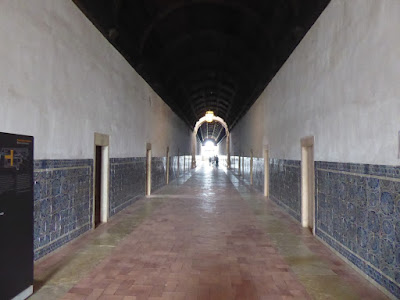We took Jane's advice and back-tracked 30 miles or so to Tomar to see the Convento de Cristo, the World Heritage castle and convent that dates from the 12th century. The site was the work of the Knights Templar, who, along with the Teutonic Knights and the Knights Hospitallier were among the most famous international
military orders of the high middle ages. Yes,
military orders,
religious military orders, as defended and justified by no less than the pope-maker Bernard of Clairvaux. The Knights Templar were founded in Jerusalem in the early 1100s and had several notable victories against Saladin, who, alas, ultimately prevailed. They were a sort of Christian
kamikaze corps who thought nothing of 90% casualties. "Merely a flesh wound." Their mission was to hold Jerusalem, protect Christian pilgrims, and most importantly, protect Christian pilgrims' property. For this latter, they became bankers, of a sort, devising letters of credit whereby the wealthy pilgrim could deposit funds in his home town but draw funds (from Templar ATMs) on the way to the Holy Land. As soldiers they were moderately successful for a time, but as bankers, they were spectacularly successful, becoming spectacularly wealthy, as religious orders did in those times. And as happened with the other orders in the later middle ages, their great wealth and power aroused the envy and enmity of kings, particularly Philip of France, who accused them of heresy (and much, much worse, unmentionable here) and ultimately persuaded the puppet-pope to have them disbanded and their properties transferred "elsewhere." This worked well for France, but in Portugal, King Dinis was a Templar fan, especially since, having failed to hold the Holy Land, the Templars were now involved in the Iberian re-
conquista. So he merely changed their name from Knights Templar to Knights of Christ, and everything carried on as if nothing had happened. Sort of like Sambo's morphing into Denny's. Anyhow, that is the gist of it (thank you,
Wikipedia) although there much more, actually interesting, to me, on the Web. And elsewhere.
 |
Castle wall; note inclined buttressing structure...inclined
so as to prevent siege engines from nudging up against the
walls; so , I wonder, why didn't Gondor think of this in
Return of the King? |
 |
| Christian arrow slit things in the walls |
 |
In the castle, approaching the convento...remember the rotunda...
muy importante |
 |
| Ruined bits of the castle |
 |
The other Manueline door; impressive enough
for me; we'll see a closer up later, and also the
famous Manueline door |
 |
| The first of several cloisters |
 |
| Gorgeous everywhere |
 |
| Double-decker Gothic cloister |
 |
| Another view of the famous Knights' Rotunda |
 |
Now approaching the Knights' Rotunda, from
the nave of the church (rather like the Aachen
cathedral, methinks) |
 |
Within; designed with the Holy Sepulchre in
Jerusalem in mind |
 |
| Over the top eastern... |
 |
Although the rotunda is 12th century, the paintings in it are
mostly 15th-16th...here is St. Anthony preaching to the fish
(St. Francis had already done the birds) |
 |
But some of it is much, much older...here, a very old St.
Christopher |
 |
| Abiding images of an incredible place... |


















































